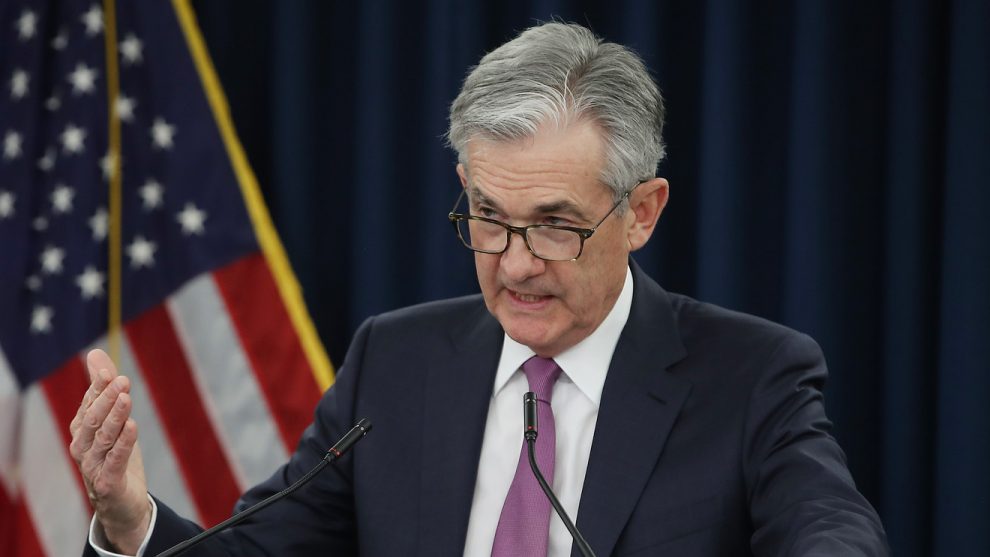
U.S. stocks retreated into the close Wednesday after Federal Reserve Chairman Jerome Powell acknowledged a slowdown in business and household spending, but described low inflation as “transitory” and denied there was a “strong case” to expect an interest-rate cut in the near term.
How did major indexes performing?
The Dow Jones Industrial Average DJIA, -0.61% fell 162.77 points, to 26,430.14, a loss of 0.6%, while the S&P 500 index SPX, -0.75% fell 22.10 points, or 0.8%, to 2,923.73. Meanwhile, the Nasdaq Composite Index COMP, -0.57% fell 45.75 points, a loss of 0.6%, to 8,049.64
Though the S&P 500 index also set a new intraday high early Wednesday at 2,954.10, the index ended up posting its worst daily performance in more than a month.The Nasdaq rose 50.61 points to 8,146 at session highs, while the Dow was up as many as 96.48 points, to reach 26,689.39.
Tuesday and Wednesday marked the first two-session slide for the Nasdaq since March 22 and 25, while the Dow had its worst day since April 9.
What’s drove the market?
After perking up briefly following the announcement of the Fed’s decision to leave the benchmark fed-funds rate at a range between 2.25% and 2.5%, stocks turned significantly lower during and after Powell’s news conference.
While the Fed statement highlighted data showing that the rate of price inflation has fallen and remains under the central bank’s 2% target, Powell stressed that he saw “no strong case” for expecting the central bank’s next move to be a rate cut, investors in the fed funds futures market have predicted. According to CME Group, fed funds futures markets are showing a 59.8% likelihood that the Fed cuts interest rates before year-end.
Live blog recap: Powell addresses reporters after Fed keeps rates unchanged
Dow component Apple AAPL, +4.91% was in the spotlight after the iPhone maker reported another fall in profit and revenue, but beat expectations for first-quarter performance. Moreover, Apple signaled that the worst is over for its China business, and did report momentum in its services businesses, which stock bulls see as key to the company’s growth. Shares rose 4.9%.
First Take: Apple is optimistic, and it isn’t because of the iPhone
Which stocks were in focus?
Shares of CVS Health Corp. CVS, +5.42% rallied 5.4% after the pharmacy and health-care services giant reported first-quarter earnings and sales that beat Wall Street expectations, while raising its outlook for the full-year 2019.
Estée Lauder Cos. Inc. EL, -0.88% shares fell 0.9%, reversing early morning gains as high as 4.9%, after the makeup manufacturer reported first-quarter sales that beat analyst expectations, while predicting revenue would grow between 7% and 8% during the full-year 2019.
Molson Coors Brewing Co. TAP, -7.54% fell 7.5%, after the company reported first-quarter earnings that fell short of forecasts.
Shares of Humana Inc. HUM, -3.62% retreated 3.6%, even after the insurer reported first-quarter earnings and revenue Wednesday morning that topped Wall Street expectations, while also raising its full-year guidance.
Yum! Brands Inc. YUM, -2.35% stock fell 2.4% Wednesday, after the Taco Bell parent reported first-quarter results.
Shares of Royal Caribbean Cruises Ltd. RCL, +6.69% rose 6.7% Wednesday, after the cruise operator reported first-quarter earnings, revenue and net yields that beat expectations.
Hotel operator Hilton Worldwide Holdings Inc. HLT, +6.45% announced first-quarter earnings growth of 16% Wednesday, well above Wall Street forecasts. Share rose 6.5%.
Chip group Qualcomm Inc. QCOM, +0.28% social-gamer Zynga Inc. ZNGA, -2.65% wearables maker FitBit Inc. FIT, +1.70% and mobile payment group Square Inc. SQ, +1.10% were scheduled to report Wednesday evening.
Read: Qualcomm short sellers are out in full force ahead of earnings
Check out: Qualcomm earnings, schmernings: Tell us more about the Apple settlement
What are analysts saying?
“The feature out of this meeting for investors is the Fed’s economic outlook, which highlights ‘sustained expansion of economic activity’ balanced with a soft global economic picture and “muted inflation pressures,” wrote Jason Pride, chief investment officer of private wealth at Glenmede, in emailed comments.
“With the U.S. economy at or near full employment, the expectation for future rate changes will essentially be a referendum on inflation, which has remained habitually below the Fed’s 2% target this cycle,” he said.
Chris Gaffney, president of the world markets division at TIAA Bank, put the whipsaw market reaction across assets down to an initial overreaction to the Fed’s tweak to IOER (interest on excess reserves), which it lowered.
“Investors took this move as an indicator that the next interest rate move will be a cut in the fed-funds rate. This is what drove the dollar lower and also triggered a drop in interest rates across all maturities of the U.S. Treasury curve,” Gaffney wrote in an email.
“Powell reiterated twice during the Q&A that this move in the IOER was not an indication of future policy but instead was a technical adjustment,” he added. “Markets reversed course following Powell’s explanation of move.”
What else was on the economic calendar?
Payroll firm ADP released its estimate of private-sector job growth in April, showing the U.S. economy added 275,000 new jobs, well above the 176,000 consensus estimate, according to FactSet. However, Mark Zandi, Moody’s Analytics chief economist and architect of the ADP report said that the figure “overstates the case” of job growth and predicted that Friday’s official government job report will show less robust employment growth.
Markit’s manufacturing purchasing managers index for April came in at 52.6, a slight uptick from the near two-year low seen last month, and above consensus expectations for a reading of 52.4, according to FactSet data.
The more closely watched Institute for Supply Management manufacturing index came in at 52.8%, well below consensus expectations of 54.7%, according to a MarketWatch poll of economists, and below the March reading of 55.3%.
The Commerce Department said construction spending fell by 0.9% in March, compared with February, below economists expectations of a 0.4% decline, per a MarketWatch survey.
How did other markets fare?
Most stock markets in Asia were closed for holidays, though Australia’s S&P/ASX 200 XJO, +0.80% closed up 0.8%, while New Zealand’s NZK-50 NZ50GR, -0.47% fell 0.5%. European stock markets were also largely closed for May Day celebrations, while The U.K’s FTSE 100 UKX, -0.44% closed 0.4% lower.
The price of crude oil CLM9, -0.56% was on the decline Wednesday, along with gold prices GCM9, -0.62% The U.S. dollar DXY, +0.16% was advancing, relative to its peers.
William Watts contributed to this article
Providing critical information for the U.S. trading day. Subscribe to MarketWatch’s free Need to Know newsletter. Sign up here.






